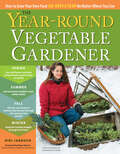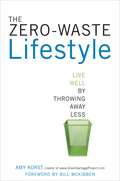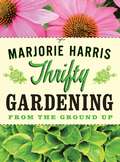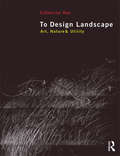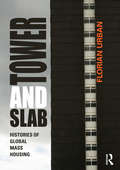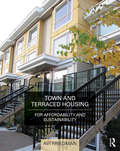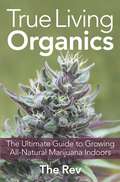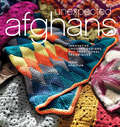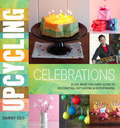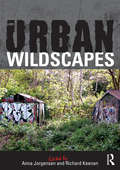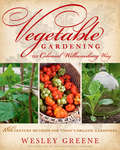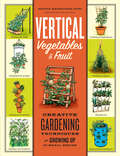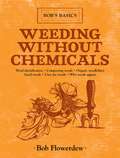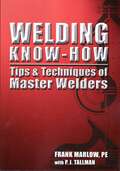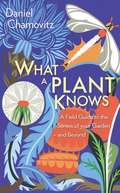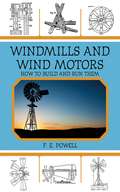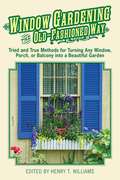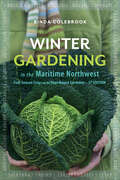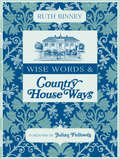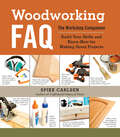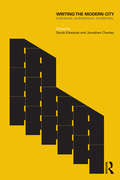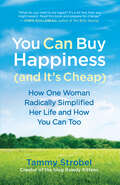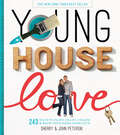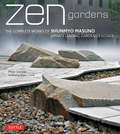- Table View
- List View
The Year-Round Vegetable Gardener: How to Grow Your Own Food 365 Days a Year, No Matter Where You Live
by Niki Jabbour Joseph De ScioseEven in winter’s coldest months you can harvest fresh, delicious produce. Drawing on insights gained from years of growing vegetables in Nova Scotia, Niki Jabbour shares her simple techniques for gardening throughout the year. Learn how to select the best varieties for each season, the art of succession planting, and how to build inexpensive structures to protect your crops from the elements. No matter where you live, you’ll soon enjoy a thriving vegetable garden year-round.
The Zero-Waste Lifestyle: Live Well by Throwing Away Less
by Amy KorstA practical guide to generating less waste, featuring meaningful and achievable strategies from the blogger behind The Green Garbage Project, a yearlong experiment in living garbage-free.Trash is a big, dirty problem. The average American tosses out nearly 2,000 pounds of garbage every year that piles up in landfills and threatens our air and water quality. You do your part to reduce, reuse, and recycle, but is it enough? In The Zero-Waste Lifestyle, Amy Korst shows you how to lead a healthier, happier, and more sustainable life by generating less garbage. Drawing from lessons she learned during a yearlong experiment in zero-waste living, Amy outlines hundreds of easy ideas--from the simple to the radical--for consuming and throwing away less, with low-impact tips on the best ways to: * Buy eggs from a local farm instead of the grocery store * Start a worm bin for composting * Grow your own loofah sponges and mix up eco-friendly cleaning solutions * Purchase gently used items and donate them when you're finished * Shop the bulk aisle and keep reusable bags in your purse or car * Bring your own containers for take-out or restaurant leftovers By eliminating unnecessary items in every aspect of your life, these meaningful and achievable strategies will help you save time and money, support local businesses, decrease litter, reduce your toxic exposure, eat well, become more self-sufficient, and preserve the planet for future generations.
Thrifty Gardening: From the Ground Up
by Marjorie HarrisBestselling author and gardening columnist Marjorie Harris offers a timely and entertaining guide for gardeners at every stage of life. Whether you're moving into your first apartment or condo, upgrading to a house, or downsizing to smaller digs, Harris shares the best tips on how to create a beautiful garden for any space — all on a budget. The highly anticipated sequel to her popular book Thrifty: Living the Frugal Life with Style, The Thrifty Gardener marries Harris's passion for gardening with her thrifty lifestyle savvy so that everyone can create a natural oasis whatever their living situation is — and without breaking the bank.
Tiny World Terrariums: A Step-by-Step Guide to Easily Contained Life
by Michelle Inciarrano Katy MaslowCreate your own tiny, living world with this beautifully illustrated, easy-to-follow guide to terrariums using soil, plants, miniature figurines, and more! Terrariums are a vibrant, unique way to inject a little greenery into any home. In Tiny World Terrariums, authors Katy and Michelle of Brooklyn&’s celebrated Twig Terrariums offer step-by-step instructions for building your own, from selecting glass containers to layering soil and filtration to adding moss, succulents, and other plants. To give each terrarium a whimsical, personal touch, Katy and Michelle demonstrate how to use tiny figurines and toys to create to-scale scenes, such as a couple at their wedding, a CSI crime scene, and Central Park in springtime. Photos of gorgeously finished terrariums and detailed instructions will empower anyone―whether green-thumbed or not―to create their own Lilliputian worlds.&“The book provides all the necessary instructions to create successfully healthy terrariums . . . But illustrations are the real delight. They show all sorts of tiny world photos labeled with container types, plant names, and more so you can more easily create contained life exactly as you envision it.&” —Wired.com
To Design Landscape: Art, Nature & Utility
by Catherine DeeTo Design Landscape sets out a distinctively practical philosophy of design, in accessible format. Based on the notion that landscape design is a form-based craft addressing environmental processes and utility, Dee establishes a framework for approaching such craft with modesty and ingenuity, using the concept of "aesthetics of thrift".Employing numerous case studies-as diverse as Hellerup Rose Garden in Denmark; Bloedel Reserve, Bainbridge Island, USA; Rousham Gardens, Oxfordshire, UK and Tofuku-ji, in Kyoto, Japan - to illustrate her ideas, the book is a beautiful portfolio of Dee's drawings, which are both evocative and to the point.The book begins with a 'Foundations' section, which sets out the basis of the approach. ?'Principles' chapters then elaborate eleven significant considerations applicable to any design project, regardless of context and scale. Following on, 'Strategies' chapters reinforce the principles, and suggest further ways of designing, adaptable to different conditions. Dee ends with a focus on 'Elements', case studies and verb lists providing sources for the designer to consider how the components - vegetation, water, terrain, structures, soils, weather, and the sky - ?might be engaged, mediated and joined.Catherine Dee’s book is for all those who would craft landscape, from the gardener, to the professional landscape architect, to the student of design
Tower and Slab: Histories of Global Mass Housing
by Florian UrbanTower and Slab looks at the contradictory history of the modernist mass housing block - home to millions of city dwellers around the world. Few urban forms have roused as much controversy. While in the United States decades-long criticism caused the demolition of most mass housing projects for the poor, in the booming metropolises of Shanghai and Mumbai remarkably similar developments are being built for the wealthy middle class. While on the surface the modernist apartment block appears universal, it is in fact diverse in its significance and connotations as its many different cultural contexts. Florian Urban studies the history of mass housing in seven narratives: Chicago, Paris, Berlin, Brasilia, Mumbai, Moscow, and Shanghai. Investigating the complex interactions between city planning and social history, Tower and Slab shows how the modernist vision to house the masses in serial blocks succeeded in certain contexts and failed in others. Success and failure, in this respect, refers not only to the original goals – to solve the housing crisis and provide modern standards for the entire society – but equally to changing significance of the housing blocks within the respective societies and their perception by architects, politicians, and inhabitants. These differences show that design is not to blame for mass housing’s mixed record of success. The comparison of the apparently similar projects suggests that triumph or disaster does not depend on a single variable but rather on a complex formula that includes not only form, but also social composition, location within the city, effective maintenance, and a variety of cultural, social, and political factors.
Town and Terraced Housing: For Affordability and Sustainability
by Avi FriedmanRecent societal changes have brought about renewed interest from architects, town planners, housing officials and the public in terraces and townhouses. The small footprint that this style of house occupies allows a sustainable high density approach to habitation, slowing sprawl and creating energy-efficient affordable living. Townhouses have been used for hundreds of years, and their evolution is covered from their inception right up to the present day. With the changing demographics of buyers in mind, Avi Friedman details how the design of these houses can be adapted to keep-up with contemporary needs. Friedman uses a systematic approach to cover the many facets of townhouses from interior design and construction methods, to urban planning issues like adjusting to the site’s natural conditions, street configurations and open spaces. This approach creates a book which will be a valuable resource for those involved in the planning, design and creation of terraced and town houses. Over 150 detailed diagrams and plans, and eighty photos, illustrate the essential elements of this style of housing. In the final chapter, lessons learnt throughout the book are draw together in ten broad ranging case study projects, showing how the various aspects can be put into practice.
True Living Organics
by The RevThe only organics grow guide is also the only book that shows how to change an existing grow room to an all-natural, synthetic-free, living, breathing cannabis cultivation space. Written in the accessible, easy-to-follow style that's won The Rev so many followers, this book sifts through the jargon surrounding organic marijuana growing and gets straight to the heart of the matter: the living soil. True Living Organics provides several different ways to create a high-quality living medium for marijuana plants. Dispensing with the basics of how to grow pot, this guide instead gives the reader a new education on what cannabis plants really need and the best way to give it to them. With over 200 color photos illustrating every topic, this book is as easy to use as it is insightful.
Unexpected Afghans: Innovative Crochet Designs with Traditional Techniques
by Robyn ChachulaUnexpected Afghans presents 29 innovative interpretations of a favorite at-home essential. From best-selling author Robyn Chachula comes an in-depth look into crocheting traditional afghans using contemporary techniques, colors and patterns.Expert designers including Kristin Omdahl, Kathy Merrick, Kimberly McAlindin, and many more, provide an abundance of fresh patterns and projects that are perfect for new and advanced crocheters as they start out beginner-friendly and become more complex, allowing a crocheter to build skills and confidence. Designers at any level will enjoy: • A detailed technique's workshop in every chapter including cables, motifs, color, lace, and Tunisian crochet. • Helpful tips from designers for working through each afghan project. • Easy-to-follow charts and diagrams. Along with tons of beautiful afghan projects for all skill levels, you'll find many of your favorite designer's biographies--giving you an exploration into their inspiration.
Upcycling Celebrations: A Use-What-You-Have Guide to Decorating, Gift-Giving & Entertaining
by Danny SeoDanny Seo is America’s leading lifestyle authority on modern, eco-friendly living. In his last book, Upcycling, Danny demonstrated how to create beautiful things with the stuff you already have. Now he returns with 100 more projects-this time focused specifically on parties and holidays. Whether you’re making dramatic party favors for New Year’s Eve, giving a unique birthday gift, creating paper lanterns for a summer BBQ, or planning the Thanksgiving table, Danny shows how you can transform the ordinary into striking one-of-a-kind objects that will make every occasion a little more festive.
Urban Wildscapes
by Anna Jorgensen Richard KeenanUrban Wildscapes is one of the first edited collections of writings about urban ‘wilderness’ landscapes. Evolved, rather than designed or planned, these derelict, abandoned and marginal spaces are frequently overgrown with vegetation and host to a wide range of human activities. They include former industrial sites, landfill, allotments, cemeteries, woods, infrastructural corridors, vacant lots and a whole array of urban wastelands at a variety of different scales. Frequently maligned in the media, these landscapes have recently been re-evaluated and this collection assembles these fresh perspectives in one volume. Combining theory with illustrated examples and case studies, the book demonstrates that urban wildscapes have far greater significance, meaning and utility than is commonly thought, and that an appreciation of their particular qualities can inform a far more sustainable approach to the planning, design and management of the wider urban landscape. The wildscapes under investigation in this book are found in diverse locations throughout the UK, Europe, China and the US. They vary in scale from small sites to entire cities or regions, and from discrete locations to the imaginary wildscapes of children’s literature. Many different themes are addressed including the natural history of wildscapes, their significance as a location for all kinds of playful activity, the wildscape as ‘commons’ and the implications for landscape architectural practice, ranging from planting interventions in wildscapes to the design of the urban public realm on wildscape principles.
Vegetable Gardening the Colonial Williamsburg Way: 18th-Century Methods for Today's Organic Gardeners
by Wesley GreeneFrom the nation's foremost historical preservation site comes a guide to traditional—and still relevant—methods and advice for planting and tending a productive vegetable gardenIn a colonial-style garden, the broccoli is purple and "turkey" cucumbers grow to three feet long; oiled paper predates plastic for sheltering spring plants; and fermenting manure warms the seedlings. Finding inspiration and value in 18th-century plants, tools, and techniques, the gardeners at Colonial Williamsburg have discovered that these traditional vegetable-growing methods are perfectly at home in today's modern organic gardens. After all, in the 18th century, organic gardening was the only type of gardening and local produce the only produce available.Author Wesley Greene founded the Colonial Garden in Colonial Williamsburg's Historic Area in 1996. He and his colleagues have painstakingly researched the ways the colonists planted and tended their vegetable and herb beds, most of which are more relevant than ever. Along with historical commentary and complete growing instructions for 50 delicious vegetables, including colonial varieties still available today, gardeners and folklorists will find weather-watching guidelines, planting techniques, and seedsaving advice for legumes, brassicas, alliums, root crops, nightshades, melons, squash, greens, and other curious and tender produce.
Vertical Vegetables & Fruit: Creative Gardening Techniques for Growing Up in Small Spaces
by Rhonda Massingham HartFor gardeners working in confined spaces, Rhonda Massingham Hart presents an ingenious solution for maximizing productivity: grow up! With tepees, trellises, hanging baskets, cages, wall pockets, and multilevel raised beds, you can reap bountiful harvests in even the tiniest growing areas. From kiwis on a clothesline to tomatoes dangling outside a window, Vertical Vegetables & Fruit shows you how to construct and maintain a thriving and abundant garden in whatever small space you have available.
Weeding Without Chemicals: Bob's Basics (Bob's Basics)
by Bob FlowerdewThe nuisance caused by weeds sprouting in your otherwise thriving garden may make you want to reach for the herbicide, but as Flowerdew writes in this installment of his Bob's Basics series, weed control can be much more simple, inexpensive, and eco-friendly without chemical intervention. Because every weed is best removed with a different method, Weeding Without Chemicals begins with a discussion of the various weed categories. No matter what sort of weed is plaguing your garden, Bob has a chemical-free way to keep it under control.
Welding Know-how: Tips & Techniques of Master Welders
by Frank M. MarlowThis book contains years of welding knowledge all in one easy-to-understand book. Filled with insights you won’t find anywhere else, Welding Know-How has step-by-step instructions for dozens of projects, plans for welding jigs and fixtures, and ideas to modify existing tools so they really work. Welding Know-How contains over 600 clear and detailed line drawings, and includes chapters on the major welding processes: shielded metal arc, wire feed, and gas tungsten arc welding, along with chapters on the major cutting processes, oxyacetylene, plasma arc, water jet, oxygen lance and burning bar. In addition, there are chapters on brazing and soldering, bending and flame straightening. There is an entire chapter on pipe and tubing plus a chapter on welding safety, and one covering welding power supplies and electrical safety. With this book you’ll finally gain control of your stick, TIG or wire feed outfit and learn how to get your “buzz box” to make more than just noise. After reading Welding Know-How you’ll see that there are no secrets in the welding shop, just knowledge that has never been written down—until now. Frank Marlow is the author of the popular shop books, Machine Shop Essentials and Machine Shop Know-How.
What a Plant Knows: A Field Guide to the Senses of Your Garden - and Beyond
by Daniel ChamovitzHow does a Venus flytrap know when to snap shut? Can an orchid get jet lag? Does a tomato plant feel pain when you pluck a fruit from its vines? And does your favourite fern care whether you play Bach or the Beatles? Combining cutting-edge research with lively storytelling, biologist Daniel Chamovitz explores how plants experience our shared Earth - through sight, smell, touch, hearing, memory, and even awareness. Whether you are a green thumb, a science buff, a vegetarian, or simply a nature lover, this rare inside look at the life of plants will surprise and delight.
Windmills and Wind Motors: How to Build and Run Them
by F. E. PowellFree, clean, and sustainable energy: wind power is an essential resource everyone can harness. This comprehensive and compact historical work provides everything you need to learn about the theory and construction of everyday windmills, from small ones intended solely as models to those large enough to generate electricity. Powell provides all the necessities to get you on your way, including detailed, step-by-step instructions, illustrations, and designs for every part of the project.Types of windmill projects include:A model windmill with sails two feet acrossA working windmill with sails six feet across, suitable for pumping waterA practical windmill with sails ten feet across, capable of producing up to one-half horse power and able to run light machineryFor those interested in developing alternate, off-the-grid sources of energy, or even those who like to build for fun, Windmills and Wind Motors is a classic, useful guide to harnessing wind power.
Window Gardening the Old-Fashioned Way: Tried and true methods for turning any window, porch,or balcony into a beautiful garden.
by Henry T. WilliamsThis vintage guide to interior decorating and gardening may have been at the height of fashion at the turn of the century, but many of its classic tips still hold true, and numerous styles and plants have come back into vogue. Learn about the very best flora and equipment to use when adding a green touch to any space, whether it's a cozy city apartment or a sprawling country villa. With over a hundred original hand-drawn illustrations and a charming, downto- earth style, Window Gardening the Old-Fashioned Way is a must-have guide for novice decorators and experts alike.
Winter Gardening in the Maritime Northwest: Cool-Season Crops for the Year-Round Gardener
by Binda ColebrookMany gardeners can supply a significant amount of their own food during the plentiful summer harvest. But the key to substantial savings on your food bill is putting fresh, homegrown produce on your table every month of the year. And in the mild, forgiving climate of the maritime Pacific Northwest, it can be easier than you might think.In Winter Gardening in the Maritime Northwest, Binda Colebrook provides a complete guide to cool-season crops and how to raise them. Gardeners from Southeastern Alaska to southern Oregon will benefit from her clear, practical advice on:Selecting and preparing the ideal winter gardening siteMaximizing production and minimizing pests with cloches, cold frames, mulches and companion plantingChoosing the best strains and hardiest varieties for a year-round growing season.An excellent companion volume to The Winter Harvest Cookbook, this revised and updated edition of the classic text will have you serving up fabulous alternatives to bland, expensive and tasteless imported supermarket vegetables in no time. Whether your favorite meals include hearty roots or succulent greens, Winter Gardening in the Maritime Northwest will help you maximize your food production year-round.
Wise Words and Country House Ways
by Ruth BinneyThis charming guide to the world of the English country house reveals all the essential hints and tips for living in and running a great house, whether you were lord, lady, maid or cook. By esteemed author Ruth Binney and with a Foreword by Julian Fellowes, creator of the much-loved Downton Abbey. Discover the rules of etiquette and manners that existed both 'upstairs' and 'downstairs', the daily routines of servants, bygone housekeeping maxims for everyone from the scullery maid to the gardener, and learn how to prepare for a grand ball. The intricate way in which the country house worked is reflected in the six chapters of this book, beginning with Keeping House and progressing to The Daily Routine and The Country House Kitchen . Since correct behavior was so important to all activities of the house, A Matter of Manners addresses the essentials of etiquette, a theme that also extends into Leisure, Entertainment and Sport . Finally Garden and Grounds focuses on everything from the cultivation of exotic fruit for the table to brewing and the care of horses and other animals. With beautiful line drawings, Wise Words and Country House Ways will be fascinating for anyone who has wondered what it would be like to be served, or in service in a grand country house.
Woodworking FAQ: The Workshop Companion: Build Your Skills and Know-How for Making Great Projects
by Spike CarlsenWhether you&’re a beginner building your first shelf or an experienced craftsman designing a new gazebo, Spike Carlson has the answers to all of your woodworking questions. You&’ll find expert advice on setting up your work area, choosing appropriate tools, working with different types of wood, and building furniture, as well as tips on joinery techniques, custom finishes, and much more.
Writing the Modern City: Literature, Architecture, Modernity
by Sarah Edwards Jonathan CharleyLiterary texts and buildings have always represented space, narrated cultural and political values, and functioned as sites of personal and collective identity. In the twentieth century, new forms of narrative have represented cultural modernity, political idealism and architectural innovation. Writing the Modern City explores the diverse and fascinating relationships between literature, architecture and modernity and considers how they have shaped the world today. This collection of thirteen original essays examines the ways in which literature and architecture have shaped a range of recognisably ‘modern’ identities. It focuses on the cultural connections between prose narratives – the novel, short stories, autobiography, crime and science fiction – and a range of urban environments, from the city apartment and river to the colonial house and the utopian city. It explores how the themes of memory, nation and identity have been represented in both literary and architectural works in the aftermath of early twentieth-century conflict; how the cultural movements of modernism and postmodernism have affected notions of canonicity and genre in the creation of books and buildings; and how and why literary and architectural narratives are influenced by each other’s formal properties and styles. The book breaks new ground in its exclusive focus on modern narrative and urban space. The essays examine texts and spaces that have both unsettled traditional definitions of literature and architecture and reflected and shaped modern identities: sexual, domestic, professional and national. It is essential reading for students and researchers of literature, cultural studies, cultural geography, art history and architectural history.
You Can Buy Happiness (and It's Cheap): How One Woman Radically Simplified Her Life and How You Can Too
by Tammy StrobelOnce, Tammy Strobel and her husband were living a normal middle-class lifestyle: driving two cars, commuting long distances, and living well beyond their means. Now they are living the voluntary downsizing; or smart-sizing; dream. In this book Strobel combines research on well-being with numerous real-world examples to offer practical inspiration. Her fresh take on our things, our work, and our relationships spells out micro-actions that anyone can take to step into a life that’s more conscious and connected, sustainable and sustaining, heartfelt and happy.
Young House Love: 243 Ways to Paint, Craft, Update & Show Your Home Some Love
by Sherry Petersik John PetersikThis New York Times bestselling book is filled with hundreds of fun, deceptively simple, budget-friendly ideas for sprucing up your home. With two home renovations under their (tool) belts and millions of hits per month on their blog YoungHouseLove.com, Sherry and John Petersik are home-improvement enthusiasts primed to pass on a slew of projects, tricks, and techniques to do-it-yourselfers of all levels. Packed with 243 tips and ideas—both classic and unexpected—and more than 400 photographs and illustrations, this is a book that readers will return to again and again for the creative projects and easy-to-follow instructions in the relatable voice the Petersiks are known for. Learn to trick out a thrift-store mirror, spice up plain old roller shades, "hack" your Ikea table to create three distinct looks, and so much more.
Zen Gardens
by Mira Locher Uchida ShigeruShunmyo Masuno, Japan's leading garden designer, is at once Japan's most highly acclaimed landscape architect and an 18th-generation Zen Buddhist priest, presiding over daily ceremonies at the Kenkoji Temple in Yokohama. He is celebrated for his unique ability to blend strikingly contemporary elements with the traditional design vernacular. He has worked in ultramodern urban hotels and in some of Japan's most famous classic gardens. In each project, his work as a designer is inseparable from his Buddhist practice. Each becomes a Zen garden, "a special spiritual place where the mind dwells."This beautiful book, illustrated with more than 400 drawings and color photographs, is the first complete retrospective of Masuno's work to be published in English. It presents 37 major gardens around the world in a wide variety of types and settings: traditional and contemporary, urban and rural, public spaces and private residences, and including temple, office, hotel and campus venues. Masuno achieved fame for his work in Japan, but he is becoming increasingly known internationally, and in 2011 completed his first commission in the United States which is shown here.The book, divided into three chapters, covers: "Traditional Zen Gardens," "Contemporary Zen Gardens," and "Zen Gardens outside Japan." Illustrated with photographs and architectural plans or sketches, each garden is described and analyzed by author Mira Locher, herself an architect and a scholar well versed in Japanese culture.Celebrating the accomplishments of a major, world-class designer, Zen Gardens also serves as something of a master class in Japanese garden design and appreciation: how to perceive a Japanese garden, how to understand one, even how to make one yourself. Like one of Masuno's gardens, the book can be a place for contemplation and mindful repose.
